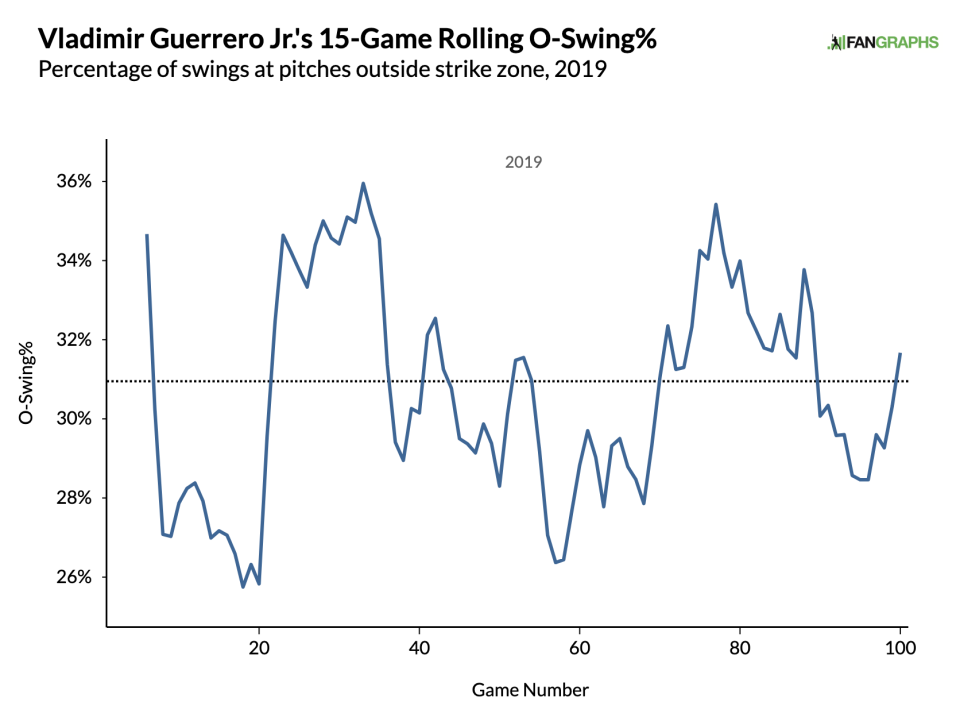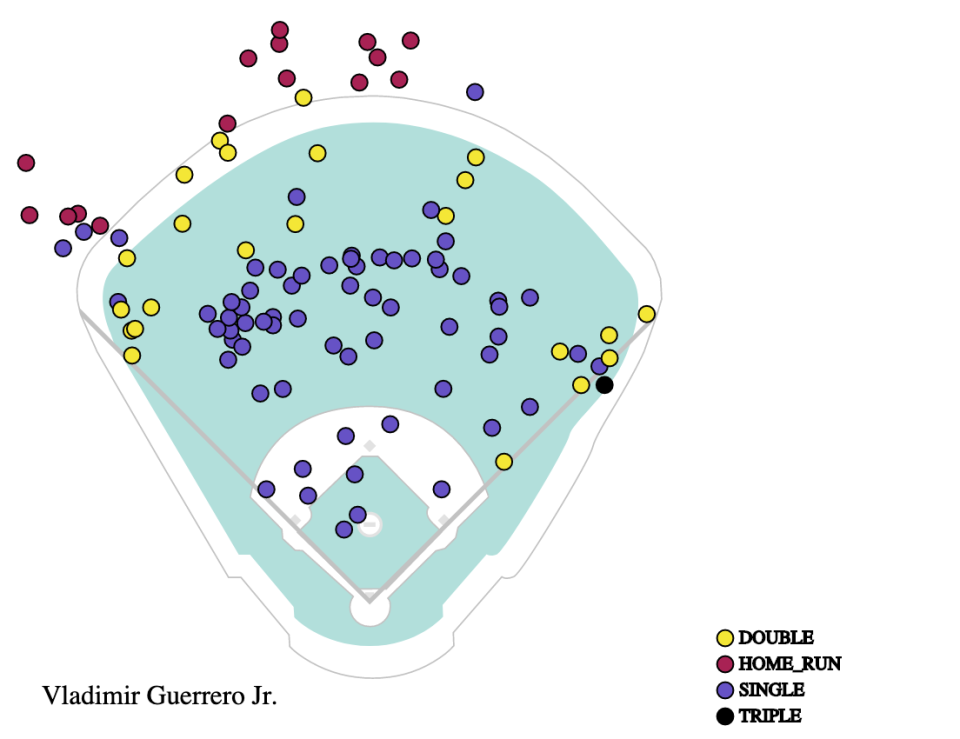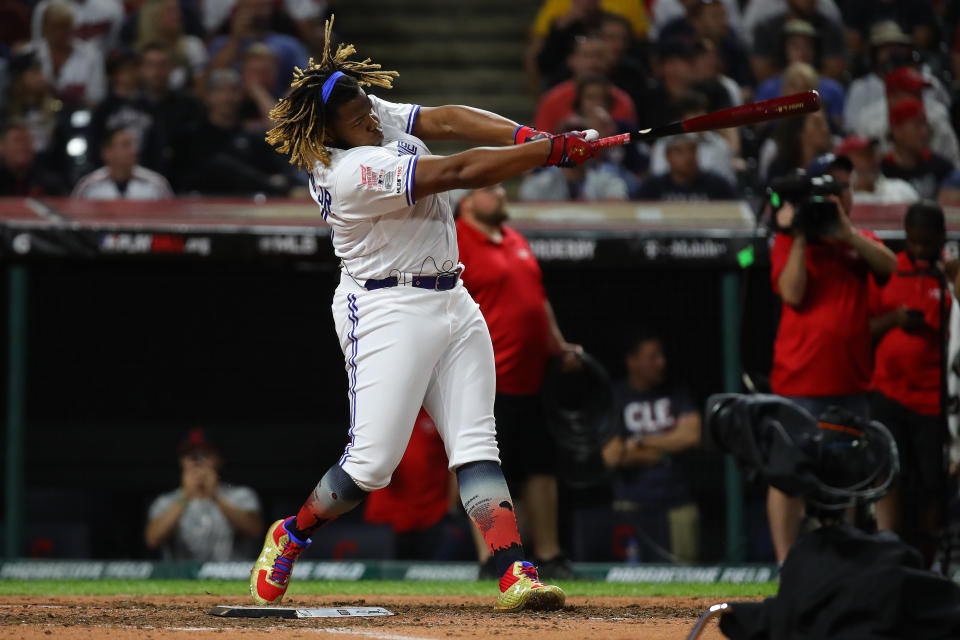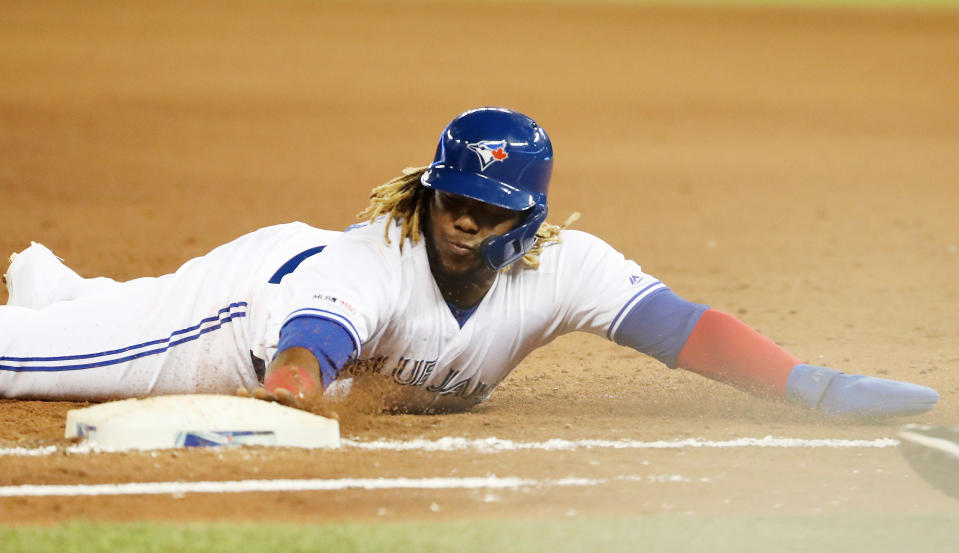100 Games of Vladdy: What we've learned about the Blue Jays' best-ever prospect
At this time last year, Vladimir Guerrero Jr. had a mythical quality. Every night it seemed like he was hitting a home run out of one stadium or another, often over a body of water or into a building of some significance. It was impossible to put a ceiling on what the 19-year-old could be capable of at the highest level.
While attempting to forecast the peak of the 20-year-old remains a treacherous task, by playing most of the season in the major leagues Guerrero Jr. has made himself more tangible. Now it’s easier for us to see his strengths and weaknesses in more precise terms. Vladdy is no longer a storm of awesomeness ready to make landfall. He’s become a baseball player.
It’s hard to say exactly when that transition happened, but it came quite quickly due to his early struggles. In contrast, the historic start to Bo Bichette’s career has kept him fantastical longer than most. You can’t really evaluate Bichette in too much detail yet. It’s hard to know how to describe a guy that’s hitting .347/.384/.669 without just throwing around superlatives.
While Guerrero Jr. is far from crystallized as a ballplayer, we’ve seen a lot. Specifically, we’ve reached the 100-game mark. That milestone is admittedly on the arbitrary side, but it’s given us a pretty good sense of what Vladdy brings to the table now, even if the heights he can reach remain anyone’s guess.
Here’s your definitive breakdown of what Vladdy has shown so far in a couple of crucial categories:
How he hits the ball

Guerrero Jr. was widely expected to be a Statcast monster from the moment he stepped on an MLB field. Unfortunately for the Blue Jays, he hasn’t quite lived up to that expectation.
To be clear, Vladdy has hit the ball hard by any reasonable standard, especially for a 20-year-old, but he hasn’t quite been in the Aaron Judge or Giancarlo Stanton tier yet. Guerrero Jr.’s average exit velocity of 89.9 mph is 65th percentile — good but not elite.
It’s also notable that he’s got a below-average launch angle at 6.9 degrees, which is a little bit low for a big power hitter. Not all sluggers make their money on towering home runs like Mike Trout or Joey Gallo — the aforementioned Judge and Stanton do just fine with more of a line drive approach — but an enormous component of Vladdy taking the next step will be finding a way to elevate the ball just a little more. His level swing can be an asset that leads to gravity-defying line drives, but it’s also played a role in an above-average groundball rate.
Guerrero Jr.’s exit velocity seems likely to increase. Whether he can bring that launch angle up is a more difficult question with a more critical answer.
Approach at the plate

One of the greatest allures of Vladdy as a prospect was his advanced feel for hitting. It’s extraordinarily rare for a 19-year-old to walk almost as much as he strikes out in the high minors, but that’s what he did last season when he had 37 BBs and 38 Ks across Double-A and Triple-A.
The fact Guerrero Jr.’s restraint at the dish runs in such stark contrast to his father’s “swing first, swing second, swing third, and if the at-bat isn’t over yet maybe reluctantly take a pitch in the dirt” approach also helped add to his legend.
On the surface it appears that Vladdy has lived up to his reputation. Both his walk rate (9.7 percent) and strikeout rate (16.9 percent) are better than the league averages of 8.5 percent and 22.7 percent, respectively. However, that’s a bit of an oversimplification of the situation because Guerrero isn’t pitched like the average MLB hitter.
Vladdy sees just 43.6 percent of pitches against him in the zone, well below the league average of 48.5 percent. That means he should be walking more than most hitters. When it comes to the rate he swings at pitches outside the zone, he chases 28.2 percent of them, which is exactly the same as the MLB average. His overall swing rate of 45.9 percent is also pretty damn close to the league standard (46.6).
As a result, it would be hard to describe him as “patient” per se, even if he’s shown himself capable of working an at-bat. While the narrative is that he seemed to be pressing early on and then found his way, his chase rate has actually fluctuated without much rhyme or reason.

On the strikeout side, his contact rate is just above league average at 75.8 precent. A great deal of his ability to avoid strikeouts comes from his high first-pitch swing percentage — which ends at-bats early — and the aforementioned low zone rate. To his credit, it does seem like the bat-to-ball success has generally been on an upward trajectory throughout the season.

Where he hits the ball

One of the primary promises of Vladdy was that he would spray the ball, which he’s done to an extent. You can see his distribution of hits in the chart above and opposing teams have only shifted him 6.3 percent of the time.
There are a couple of caveats here. The first is that there might actually be some shifting possibilities with Guerrero Jr. that opposing teams are ignoring. His infield slice chart shows that he’s hitting almost everything up the middle or the the left. Vladdy doesn’t seem like the type who’d try to bunt down the first base line for a base hit either.

It’s also notable that while Vladdy uses the whole field, he’s rarely taken it to the opposite field with authority. The 20-year-old has yet to hit a home run to right field and is slugging just .397 on hits in that direction. Interestingly, he hasn’t been lethal pulling the ball either, where he’s slugged just .566 compared to a league average of .665.
The fact he’s done most of his damage to centre field is certainly impressive, but the efficacy of that approach is rather ballpark-dependent. In some parks, centre is a black hole where baseballs tend to disappear.
At some point, Vladdy is going to start turning on the ball with a little more authority. Whether the opposite-field power becomes an important component of his game is more of an open question.
Raw power

Just about any publicly-available scouting report was giving Guerrero Jr. a perfect ‘80’ rating for his raw power coming into 2019, and for good reason. The 20-year-old has an extremely rare combination of elite bat speed and immense natural strength and no one doubts his ability to pound the baseball.
Vladdy’s power numbers, which are more good than elite at this point, might’ve had some observers worrying they overrated his ceiling for pure thumpage. Anyone who saw him every day at batting practice would have been less worried, but at the Home Run Derby the whole world saw what he was working with.
Even between the lines, the raw power has come to the fore. Guerrero Jr.’s max exit velocity of 118.9 mph is the second-highest in baseball this year and his average home run distance of 418 is sixth among the 245 hitters with at least 200 balls in play this year.
Guerrero Jr.’s power ceiling hasn’t been reached as consistently as some imagined coming into the season, but it remains as high as ever.
Defence

Vladdy is not a good defensive third baseman right now.
This shouldn’t be surprising to anyone considering his youth, his frame and the fact his deficiencies with the glove were supposedly (though obviously not actually) the reason he wasn’t in the major leagues sooner.
It doesn’t matter what measure you use, Guerrero Jr. grades out as a problem at third. Advanced metrics like DRS, UZR and FRAA say he’s cost the Blue Jays 4, 9.2 and -5.7 runs in the field respectively. His 14 errors are the second-most among third basemen, even though he didn’t play for the vast majority of April. Even the good old-fashioned eye test can easily tell you this guy has a lot of work to do.
With that in mind, the pertinent question isn’t “How good a third baseman is Vladdy?” Instead, it’s become “Can this guy be a third baseman?” The answer to that isn’t 100 percent clear. It also depends on what level of third base play the Blue Jays are willing to accept.
Guerrero Jr. hasn’t been a rookie-season Ryan Braun-level disaster at the hot corner. A more apt comparison would be Miguel Cabrera, who provided the Tigers with some below-average work there in order to accommodate Prince Fielder at first base. If the team construction is right, the whole thing could work. For it to make sense for Guerrero Jr. to stay at third long term, the Blue Jays probably need a first baseman who absolutely needs to be in the lineup. A more flyball or strikeout-focused pitching staff could help as well.
In terms of tools, what Vladdy has, not unlike his father, is a great arm. He can make close plays look easier than they should be and complete throws many of his compatriots cannot. That’s a good foundation, but a severe lack of range limits its utility. Theoretically, the blueprint for Guerrero Jr. to have defensive success might be a guy like Jhonny Peralta, who didn’t have the typical lateral quickness for his position (shortstop) but was virtually flawless on double plays and almost never made an error. A lack of range can be overcome to some extent, but everything else you do has to be extraordinary. That’s far from the case with Guerrero Jr. so far.
Baserunning

Guerrero Jr. is not built to be a force on the bases, and he certainly hasn’t been thus far. The 250-pound rookie has yet to swipe a bag, and most of his baserunning contributions have been negative.
Per FanGraphs, his UBR is -2.7 and he’s lost 1.1 runs in value by grounding into double plays. Add in -0.6 runs from one caught stealing (to be fair, a failed hit-and-run), and you’ve got -4.4 baserunning runs — the 12th worst number in the majors.
Vladdy’s sprint speed is 36th percentile, so you wouldn’t expect to see good numbers here, but what we have seen is a bit discouraging. Early in the year, the rookie turned a couple of doubles into singles, although recently he’s had a few hustle doubles.
Realistically, this is going to be the least interesting part of Guerrero Jr.’s game going forward because the potential for growth is limited and it won’t make or break his value. What the Blue Jays are hoping for is that he doesn’t cost them too much on the bases, with the understanding that negative value isn’t virtually inevitable.
That there is just about the polar opposite of a compelling storyline.
More Blue Jays coverage from Yahoo Sports

 Yahoo Sports
Yahoo Sports 
